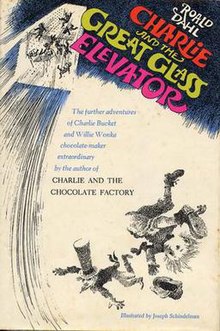Charlie and the Great Glass Elevator
 Original book cover of Charlie and the Great Glass Elevator with illustrations by Joseph Schindelman | |
| Author | Roald Dahl |
|---|---|
| Illustrator | Joseph Schindelman (1st U.S. edition) Faith Jaques (1st UK edition) Michael Foreman (2nd edition) Quentin Blake (3rd edition) |
| Language | English |
| Genre | Science fantasy Children's novel |
| Publisher | Alfred A. Knopf |
Publication date | 1972 |
| Publication place | United Kingdom |
| Media type | Print (Hardback & Paperback) |
| Pages | 202 |
| ISBN | 0-394-82472-5 (first edition, hardback) |
| OCLC | 314239 |
| LC Class | PZ7.D1515 Ck3 |
| Preceded by | Charlie and the Chocolate Factory |
Charlie and the Great Glass Elevator is a children's book by British author Roald Dahl. It is the sequel to Charlie and the Chocolate Factory, continuing the story of young Charlie Bucket and chocolatier Willy Wonka as they travel in the Great Glass Elevator. The book was published in the United States by Alfred A. Knopf, Inc. in 1972, a year after Willy Wonka and the Chocolate Factory, and in the United Kingdom by George Allen & Unwin in 1973.
Although the original book has enjoyed several screen adaptations, The Great Glass Elevator has never been adapted for a visual medium. However, it was adapted for audio by Puffin Audio Books starring Neil Answych as Charlie Bucket and Gordan Fairclough as Willy Wonka, and the second half of a BBC adaptation for Radio 4 in 1983.[1][2]
Plot
[edit]Charlie and his family board the flying Great Glass Elevator to return to the chocolate factory now that Willy Wonka has rewarded Charlie with its ownership. When Wonka attempts to bring the Elevator high enough to punch back into the factory, it accidentally goes into orbit. Wonka docks them instead at the empty Space Hotel "U.S.A.", which is coincidentally nearby, causing baffled officials back on Earth (including U.S. President Lancelot R. Gilligrass) to accuse the group of being foreign enemies. Wonka tricks them by loudly singing gibberish, pretending to be an alien, but is interrupted by the discovery that the hotel contains actual dangerous, shape-changing aliens known as Vermicious Knids. The band escapes back into orbit in the Elevator.
Once they leave, the President allows the Commuter Capsule, carrying astronauts and Space Hotel staff, to dock with the Space Hotel. Upon entry, the Knids devour several staff members, prompting an immediate evacuation. The Elevator, having circled around the Earth, braves the swarm of Knids to tow the damaged Capsule out of danger. During a last attempt by the Knids to tow the craft away themselves, they are incinerated by Earth's atmosphere. The Elevator crew releases the Commuter Capsule and crashes through Wonka's factory roof. Upon landing, Wonka is greeted warmly by the Oompa-Loompas, who were concerned about his prolonged absence from the factory.
Back in the factory, Charlie's three bedridden grandparents refuse to budge. Wonka offers them rejuvenation pills called "Wonka-Vite", but they overdose, resulting in two becoming babies and Georgina vanishing, having become −2 years old. Charlie and Wonka ride the Elevator to "Minusland" to find her, and Wonka sprays her with the opposite of Wonka-Vite – "Vita-Wonk" – to age her again. Upon returning, they discover that Georgina is now 358 years old. Wonka gives her another calculated dose of Wonka-Vite to return her to normal, then gives each of the babies enough Vita-Wonk to restore them, too.
Immediately afterwards, Wonka gets a letter from President Gilligrass, thanking everyone for their heroic efforts and inviting them to the White House. The group celebrates, and the prospect is enough to finally bring the three grandparents out of bed to join in.
Trivia
[edit]The premise of people traveling in an elevator has been used before in children's books. Dutch author Annie M.G. Schmidt wrote the book Abeltje 19 years earlier, later adapted into the film The Flying Liftboy, with a similar storyline.[3]
Editions
[edit]- ISBN 0-394-82472-5 (hardcover, 1972)
- ISBN 0-394-92472-X (library servings, 1972)
- ISBN 0-04-823106-1 (board book, 1973)
- ISBN 0-14-030755-9 (paperback, 1975)
- ISBN 0-14-032043-1 (paperback, 1986, illustrated by Michael Foreman)
- ISBN 0-14-032870-X (paperback, 1988)
- ISBN 0-670-85249-X (hardcover, 1995)
- ISBN 0-14-037155-9 (paperback, 1995)
- ISBN 0-14-038533-9 (paperback, 1997)
- ISBN 0-375-91525-7 (library binding, 2001)
- ISBN 0-14-131143-6 (paperback, 2001)
- ISBN 0-375-81525-2 (hardcover, 2001)
- ISBN 0-14-240412-8 (paperback, 2005)
- ISBN 0-141-80780-6 (audio CD read by Eric Idle)
- ISBN 978-0141357850 (paperback, 2018, colour edition illustrated by Quentin Blake)
References
[edit]- ^ "BBC Genome Project, Radio Times 1923–2009". Retrieved 26 December 2020.
- ^ "Charlie and the Great Glass Elevator".
- ^ "Charlie and the Great Glass Elevator". Scholieren.com (in Dutch). Retrieved 18 September 2024.
- Charlie and the Chocolate Factory
- 1972 British novels
- Fiction set in 1972
- Science fantasy novels
- Sequel novels
- Alfred A. Knopf books
- British children's novels
- British fantasy novels
- British science fiction novels
- Fiction about shapeshifting
- Fiction about rapid human age change
- Novels about extraterrestrial life
- Novels set in factories
- Novels set in hotels
- Novels set in one day
- Novels set in outer space
- Novels set on aircraft
- Works set in elevators
- White House in fiction
- 1972 children's books
- Children's fantasy novels
- Children's books set in hotels
- Children's books set in outer space
- Children's books set in factories
